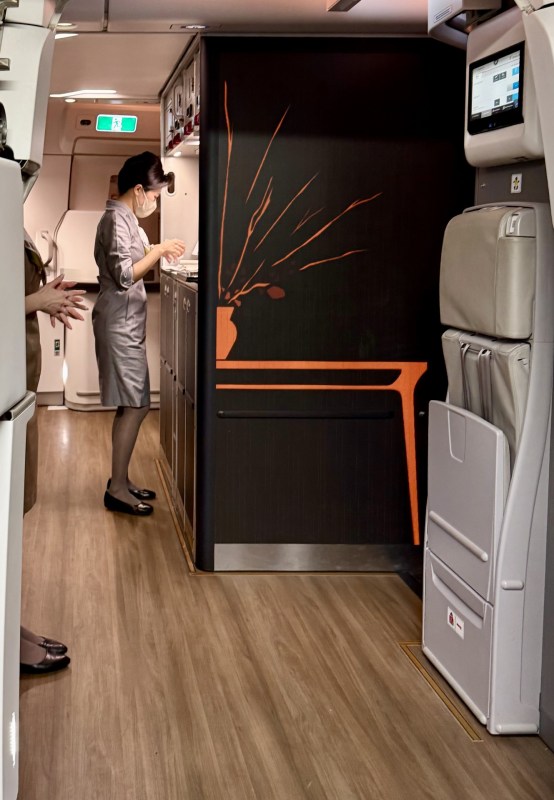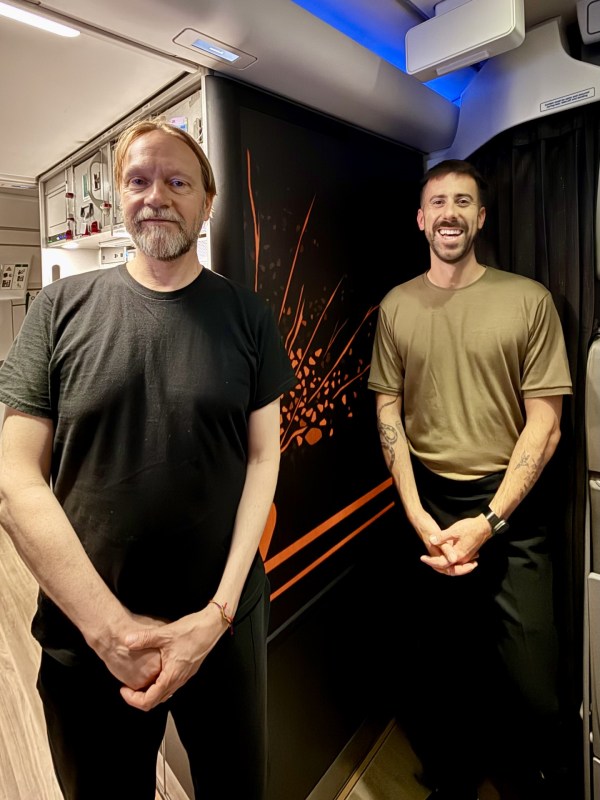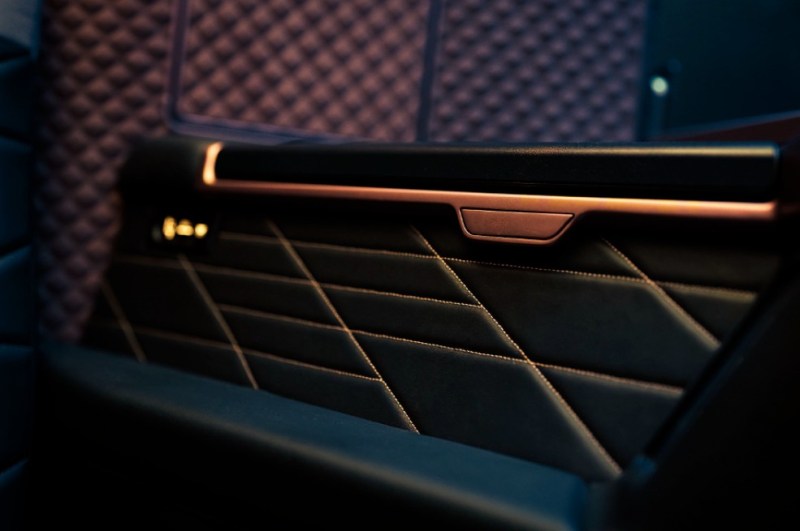Air travel can often seem like a means to an end. You must journey hundreds or thousands of miles, and comfort takes a back seat to reaching your destination. But cramped, crowded cabins can feel like riding a school bus, making a flight something to endure rather than enjoy.
But what if an airplane cabin were a tailored space akin to a luxury hotel? What if designers considered every aspect, from the lighting to the dimensions to the materials, to ensure the in-flight experience was something to look forward to?
To answer those questions, I spoke to Johannes Lampela, Head of Industrial Design at Designworks, a BMW Group Company. Here’s what he’s been working on — and what the future holds for passengers.
Creating a hospitality experience at 35,000 feet

The Manual: What trends are you seeing? What’s happening in the world of cabin design?
Johannes Lampela: There’s a lot happening. I’ve been working in this industry for about 20 years. Spent most of the first ten years working on business aviation, VIP aviation, and then the last, a little bit over ten years, on the commercial side with leading airlines like Singapore Airlines.
The most exciting work has been recent work with STARLUX because it’s a start-up. So you have a little bit more freedom, if you will. But overall, I would say that the level of design across the board, attention to detail, and how brand is expressed is evolving a lot and changing.
Airlines typically always had a very strong brand identity based on their corporate colors, which is something that even fast food restaurants don’t do anymore. So it has evolved from not needing to always have your brand represented by a caricature, but more about the brand feeling.
We often say that it’s equally important to have the brand be felt as it is to be seen. You know which airline you’re flying, you book the ticket, and then you board the aircraft; you, of course, see the aircraft from a distance with the livery, and know what airline it is. Then you get on board, and then it is repeated over and over what brand you’re in. And when I flew our design of STARLUX just two weeks ago, we actually don’t put any logos anywhere on the seats.
We did that intentionally because STARLUX is a new airline, so the logo really doesn’t mean anything to the passenger because they’re probably experiencing it for the first time or the first few times. So you, in a way, need to create the reputation before the logo means something. So we decided to leave all the logos out and have just a feeling of the brand through details, through patterns, through nuance. And it definitely created more of a hospitality-like atmosphere where you felt like, Oh, I’m in a boutique hotel, not just A to B transportation.
TM: Could you describe some of the STARLUX design elements and how they create that feeling of the brand?
JL: So I think STARLUX creates that feeling of the brand immediately when you board the aircraft because we created this illuminated entry panel. So if you board from door one or door two, you always see a galley. There are some perpendicular walls to the aisles, whether you turn left or right, from door two. Those panels have this dark surface that has an illustrated graphic design of a sideboard, like a silhouetted credenza with a vase, some flowers, and branches.
But it’s illustrated in this almost Asian calligraphy style. The illustration is backlit in this warm amber goldish color. It immediately gives you a sense that this is a hospitality experience. It harkens back to you checking into a luxury hotel. Normally, with a galley, especially lavatories, the first impression of an aircraft is very utilitarian. Especially if you’re a premium passenger, you might have boarded from the lounge. Or even if you’re an economy passenger, the airports — international terminals — are so nice that the experience always drops when you get to the aircraft from the airport, from the lounge. And we want it to actually continue to be [at the] same level or even higher. So there’s that first impression.
When you get to the cabins, you see a lot of rich, layered tones. So, we use a lot of darker tones inside the business suites, for example, because darker tones actually make the space feel more intimate. There’s a misconception that if you do a small space all in a light color, it somehow feels larger. But what it actually does is expose the smallness of the space.
If you do it darker, the space, the surround, in a way disappears, and then you can highlight features and elements, focal points. Then you focus more on those, rather than the space as a whole. So I think that’s what we were able to achieve… It feels very intimate, rich, and has layered tones.
We often talk about layering. What we mean by layering is that the experience is not flat. Flat experiences, you glance at it and you kind of realize, okay, I get what this is. And a rich, layered experience is that you are intrigued at first impression. And then you continue to discover details and layers that keep enriching that experience. So it continues longer. The excitement and the discovery last longer.
The role of design in meeting passenger needs

TM: So when you’re designing these interiors, how do you identify the user needs?
JL: So a lot of the user needs, if we work with an experienced airline, they tend to give us a lot of research and surveys, and pain points, because industrial design, at its base, is always improving from the current. That’s basically what industrial design is.
It’s problem-solving, it’s making things look, function, feel better. So we analyze all the current pain points. It might be about the comfort of the seat kinematics and the transitions. It might be certain maintenance issues, like wear and tear in certain areas of the seat or aircraft.
Also, more thinking of softer sides, of making the passenger feel calm. In STARLUX, we tried to convey a feeling of, or qualities of, being at home. Not looking like home, but creating that same level of comfort that one has in their home. So, it is a lot of analyzing what the opportunities are, what the pain points are, and then agreeing with the client on criteria of what we’re trying to achieve.
It’s also very important for us always to position clearly the goal that we want to create. When a client says, we want something that is very modern, we don’t just [say] we can just now do a very modern design. We quickly show some images and align. This is what we interpret as modern for you. Are we aligned? Because it can be quite different from an airline executive or a fleet manager to a cutting-edge BMW designer, what is modern.

TM: This is so interesting. And what about inspiration? Where do you and your team look?
JL: We have the luxury of being surrounded by so many different esigns for different industries. So, as a design organization, we are often inspired by our colleagues’ work. Because we do work for all the BMW brands: Rolls-Royce, Mini, BMW. We do work in commercial transportation, trains, planes, boats. We have global studios, we exchange projects.
I was very much inspired by what our Munich colleagues did for this electric hydrofoiling boat called the Icon. And yeah, it’s just like inspiration comes from just seeing great design, and it doesn’t necessarily need to be that you apply something directly, but it inspires you more to elevate. So if I see what they did to that boat, it is groundbreaking in that segment. So then, when we start working on another project for another industry, we think, how can we elevate this industry?
How can we elevate this brand? In some industries, it’s smaller steps, and in some other industries, it can be a bigger leap, where maybe design is not so prevalent in those industries.
TM: What about sustainability? How are you all incorporating that into your design work?
JL: Each of our global studios has a design team called CMF: Color, Material, Finish, and they specialize in materials that are used in designs. For BMW, we have conducted a research program called visionary materials on sustainable materials, circular materials, often working with new material suppliers or developers.
We were actually scouting these start-ups for BMW that are doing interesting new sustainable developments and are maybe in the early stages. They are not necessarily produced in the quantities required for automobiles, but interesting developments in something else. But we can see that maybe in a few years, they could be used in one of our automotive programs.
So we did this — it’s an annual program, an ongoing program where we do these collaborations with these start-ups and develop different materials. And then we select a few of them and apply them to a part in a car, which can be a seat or a center console. And then we do a big presentation at the BMW headquarters and invite all the different development teams to see these early ideas and early materials, and then we get them into their development streams.
In some instances, BMW even invests into some of these start-ups. So we’re constantly looking at multiple lengths of materials that could be readily available in a decade, or materials that could be available now. And yeah, it’s a wonderful opportunity because it is funded by BMW to have this ongoing research. Then when we do our external client work, we are always pushing for sustainability and circularity in the way we’re designing, and then we align on the goals and the messaging. Interestingly, there are some companies that actually do quite a bit of sustainable or circular design thinking, but they don’t want to necessarily make it a talking point. They just see it as part of responsible, good design.
TM: What do you see for the future? Where is there an opportunity to break new ground in these designs?
JL: There are so many opportunities. I think if we’re talking about specifically aircraft, aircraft cabins, I think the incorporation of higher speed connectivity and new information technologies, VR, AR. I think digitalization and better digital experience will be almost like the great equalizer, if you will. Because at the moment, the experience between economy and first class, it’s drastic. We actually compare it often to automotive that Rolls-Royce is only like I don’t know, 20%, 30% larger than BMW 3-series or Mini. But a first class in aircraft is six times larger than the economy.
So the space difference you give to one passenger versus another is completely different. So we’re looking into how you can then create these types of qualities in a smaller space that we’re able to do the quality differentiation and experience differentiation within automotive with very small incremental increases. So I think digitality and digital experiences can really elevate the lower classes where you don’t have that much space, and if you go more virtual with your entertainment and incorporate gaming experiences, you’re not limited to the pixel size of your screen.




